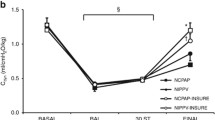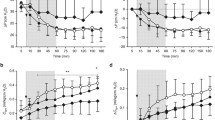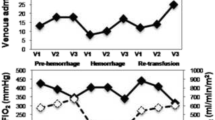Abstract
Gas ventilation following instillation of perfluorochemical (PFC) liquid, partial liquid ventilation (PLV), improves gas exchange and pulmonary mechanics in neonatal animals and humans with severe respiratory distress. The effect of PLV on cardiac contractility, performance, pulmonary blood flow and ductal shunt has not been fully described. To this end, we evaluated these indices of cardiopulmonary function in eight conventionally gas ventilated, surfactant-treated premature lambs (125 days gestation) before and during PLV. Animals were instrumented with central venous and aortic lines. Serial evaluation of arterial blood chemistry/pressure, and pulmonary mechanics was performed; cardiac contractility, performance, pulmonary blood flow and ductal shunts were serially assessed by echocardiography. As compared to conventional gas ventilation, during PLV there was a significant decrease in left ventricular meridian (22.5 ± 6.6 SE vs 8.1 ± 1.4 SE g/cm2, P < 0.02) and circumferential wall stress (54.1 ± 16.5 vs 24.4 ± 3.8 SE g/cm2, P < 0.04) at end systole. The fall in wall stress at end systole was associated with a significant decrease in left ventricular internal diameter (1.2 ± 0.05 SE vs 1.04 ± 0.045 SE cm; P < 0.01). There were no significant changes in heart rate, systemic arterial and central venous pressures, systemic vascular resistance, left ventricular shortening and ejection fractions during PLV. The decrease in wall stress was associated with a significant decrease in mean airway pressures (15.9 ± 1.1 SE vs 9.9 ± 0.2 SE cmH2O; P < 0.05) and ostensibly a change in intrathoracic pressures during PLV. There were no significant differences in blood flows (pre vs during PLV; ml/min/kg): pulmonary (226 ± 62 SE vs 293 ± 65 SE), aortic (237 ± 36 SE vs 204 ± 21 SE), and left to right ductal (119 ± 25 SE vs 105.5 ± 26 SE) measured before and during PLV.
Conclusion Cardiac output and pulmonary blood flow do not change significantly during PLV and therefore do not appear to contribute to improved gas exchange. This stable cardiac performance occurs at lower wall stress and thereby more advantageous energetic conditions.
Similar content being viewed by others
Author information
Authors and Affiliations
Additional information
Received: 18 July 1996 and in revised form: 28 May 1997 / Accepted: 31 May 1997
Rights and permissions
About this article
Cite this article
Davidson, A., Heckman, J., Donner, R. et al. Cardiopulmonary interaction during partial liquid ventilation in surfactant-treated preterm lambs. Eur J Pediatr 157, 138–145 (1998). https://doi.org/10.1007/s004310050786
Issue Date:
DOI: https://doi.org/10.1007/s004310050786




